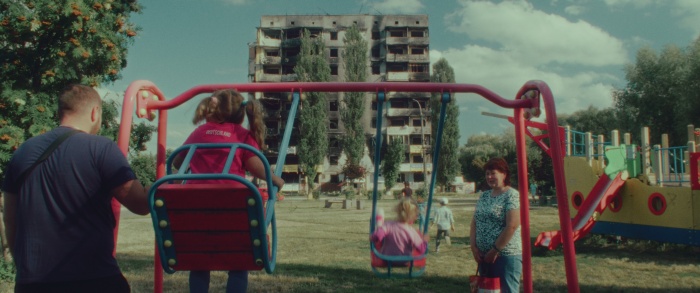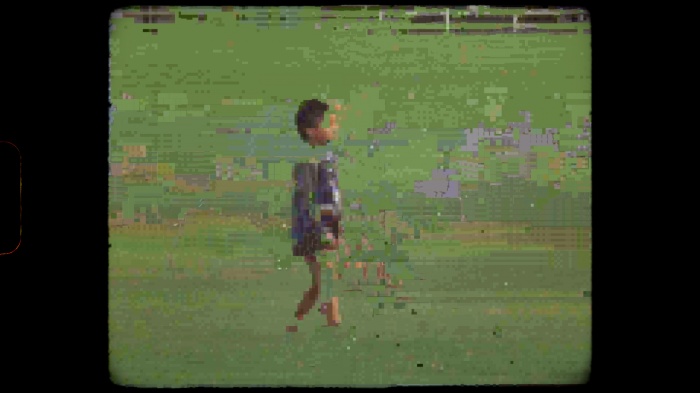
The DOCU/ART programme was created as such that would push the boundaries of our understanding of documentary cinema. It usually included films primarily interesting by their form, created by authors searching for a new documentary film language. The DOCU/ART-2023 corresponds to this idea in form and content: the filmmakers represented in this programme ask questions about the future in line with the key theme of this year's Docudays UA. And they are looking for answers: in their heads, the recent past and the events in Ukraine related to Russia's full-scale invasion.
In an hour and twenty-three minutes, Polish cinematographer Piotr Pawlus and editor Tomasz Wolski take the viewer through the Kyiv suburbs, which have just been liberated from Russian occupation, to Kharkiv and, further, to the eastern front. Their film In Ukraine, which premiered in the Forum programme at the Berlin Film Festival in 2023 (likewise the other two films from the Docu/Art programme), is a documentary of observation where each scene unfolds popular media images of this war.
Destroyed Russian tanks on the side of a busy road, houses with broken windows, the bridge to Irpin, people living in the Kharkiv Metro, Ukrainian soldiers waiting out the shelling in the trenches - this is a standard set for any photo reportage of the war in Ukraine. However, these photos gain more context in motion, and Wolski and Pawlus don't leave until the scene before their eyes acquires volume. Those are fragments In Ukraine is woven from. Sometimes these fragments of Ukrainian wartime reality are surreal, sometimes bitter with the glimpses of beauty (which the directors emphasise with an Instagram-like colour correction) and care for the people around you, for your homes, for life itself.
There is hardly anything new here for Ukrainian viewers, who have had enough images and photos of the last fifteen months. However, watching In Ukraine is useful because it also allows us to understand the optics of foreigners, those who arrived from a neighbouring country but at the same time are trying to deal with the complex, multi-layered, and sometimes irrational reality of Ukrainian wartime, and to recount what they realized to other viewers, who come mostly from the Western world. This is an exercise in the audience's trust and critical attitude towards the people who came to make films about the Russian invasion and how it changed our lives.
The Slovak filmmaker Viera Čákanyová is trying to interpret the brutal reality in which we either already exist or will soon be, the reality when the digital finally intertwines with the 'reality' and replaces it. Her experimental Notes from Eremocene is an anthropological, phenomenological, and at the same time, very personal attempt to imagine what the gloomy future of humanity will look like.
In the film, the director separates herself from her digital alter ego, uploaded to the digital world, and asks AI about her original self. The search for an existential source turns into sometimes ironic but gloomy dialogues between the protagonist and a chatbot (it doesn't matter whether they are real or written by the director), which frame the director's message: the victory of computer technology in a world without ethical principles and responsible resources consumption will mean the end of humanity.
The appeal to personal experience gives volume to this manifesto against climate change and human gluttony (the film includes footage of hunting), and thoughtless digitalisation. "I feel depressed," says the protagonist. "That's perfectly fine," someone answers in a robotic voice, someone on the other side of a devastated person in an age of loneliness.
The backdrop is chaotic analogue footage (the digital is no longer trusted) resembling more of a diary notes and extensive quotes from the American biologist Edward O. Wilson, who warned us a decade ago that humanity could be left alone if it didn't tame its appetites, and the founder of Bitcoin, Satoshi Nakamoto; and a rendering of a black hole to the music of Nick Cave, who asks in his pessimistic manner, "Who cares what the future brings?".
Who cares about the future? Those who have been deprived of justice would answer the director of the Argentine film The Trial, Ulises de la Ordena. The director compressed 530 hours of footage of the 1985 trial of the leaders of the Argentine junta to almost three hours, which mainly consist of testimonies of survivors of torture and abuse (we warn you about this, because in Ukrainian realities, watching such testimonies can be retraumatazing).
The accused in this trial are the leaders of the military dictatorship who ruled the country from 1976 to 1983, and called themselves Process of National Reorganisation and ruthlessly dealt with the opposition or those suspected in such activity. Nine members of the totalitarian government, including leader Jorge Rafael Videla, were accused of kidnapping, murder, torture, and crimes against humanity committed against 8,000-9,000 people, according to approximate estimates. Nearly all of the defendants received prison sentences but were later released due to an amnesty that was later declared unconstitutional. Trials related to the missing people during the junta's rule are still ongoing: a total of 1,058 people have been sentenced, another 964 died during the trials, and 22 are still at large. 
The desire for justice can be the only motivation to live, as The Trial shows. Leading the audience through the Dantean circles of hell (the film uses this metaphor three times): repression of students, trade unionists, confiscation of property, robbery, blackmail, kidnapping, abuse of relatives, disregard for the bodies of those killed after torture and mass murder, Ulises de la Ordena also paints portraits of those who take part in the trial. Not an easy task, given that there were only two cameras at the trial, and they filmed people in a certain way (for example, all the witnesses were filmed from behind because they, like the camera, were turned to face the judges).
Confident in their rightness, former junta officials and their cynical lawyers; witnesses – survivors of abductions and torture and their relatives, ready to testify openly (the trial involved 833 witnesses); people who came to the trial and could not help but react to what was said during the trial; the tired prosecutors who made great efforts to get these testimonies into the courtroom (despite blackmail and enormous pressure on the witnesses by the former junta), and, in fact, the judges whose task is to stick to the procedure so that the perpetrators receive the punishment they deserve.
The film does not mention it, but the Argentine junta was actively supported by former US Secretary of State Henry Kissinger, whose controversial quotes about Russia's war against Ukraine became viral in Ukrainian social networks and media. According to The Guardian, which cites declassified US national intelligence files, Kissinger attended the World Cup in Argentina during the junta's rule and tried to prevent then-newly elected President Jimmy Carter from influencing the Videla regime. This is another reminder that systemic injustice, human rights abuses, and impunity have incredibly similar patterns and lead to terror worldwide.
With access to such important and complex material as archival footage from the junta's trial, Ulises de la Ordena seeks and finds ways to tell about one of the most important and painful topics for his country. He managed to use archival footage, which limited the creative process and made The Trial not a dry recounting of three months of court proceedings but an exercise in humanity and a genuine act of remembrance.
Main photo: a still from the film Notes from Eremocene
Text: Daria Badior
_____________
The 20th anniversary of Docudays UA is held with support from the Embassy of Sweden in Ukraine, the Embassy of Switzerland in Ukraine, the Ukrainian Cultural Foundation, US Embassy in Ukraine, the Embassy of Ireland in Ukraine, the Embassy of Denmark in Ukraine, the Embassy of Brazil in Ukraine, the Polish Institute in Kyiv and the Czech centre Kyiv. The opinions, conclusions or recommendations do not necessarily reflect the views of the governments or organisations of these countries. Responsibility for the content of the publication lies exclusively on the authors and editors of the publication.